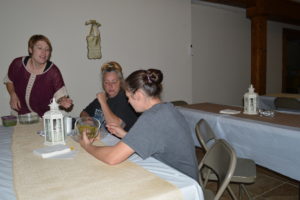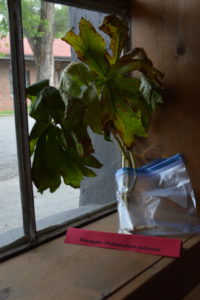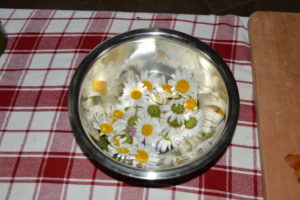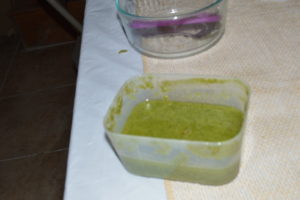When you walk through the woods or along the road, do certain plants seem to pop out at you? The rest receding in a sort of hazy, picturesque muddle? Blackberries? Poison ivy, perhaps? Here at ASPI we want a lot of them stand out – because you can eat them! (Not the poison ivy. . . please.)
There was so much interest in our Wild Edibles workshop we are going to add another workshop this fall. First, as always, a disclaimer: Start with small amounts of any new food, some wild edibles are slightly medicinal – some strongly so, and you can develop allergies at any time. If you are highly allergic to pollen, proceed with eating flowers cautiously, if at all. Collect from sites legally, responsibly (leaving enough for a wild population), and with an eye to the surrounding area. (Do not collect from sites recently sprayed with pesticides or where a large amount of traffic runoff occurs.) Finally, be positive in your identification. Although there are far more edible species of wild plants than most of us dream, remember: All plants are edible; some of them only once. -anon
So what are we sampling here? Wild Violet chips. Those little purple, sometimes white, violas that will take over a garden spot. Excellent in vitamin C, fiber, and lots of other good things. Eat them raw in salads, with cooked greens, or like here roasted with a little olive oil and salt. These were a huge crowd favorite! There was not a crumb left in the bowl. Caution: African violets are NOT wild violets. African violets (grown mostly as a house plant are toxic.)
You can eat plantain the exact same ways. The young leaves are virtually indistinguishable from other salad greens, but are more nutritious than most.
Mayapples will be ripe soon – just eat the fruit, not the seed or the leaves! Hopefully, you already know your spot because as the fruit ripens, the leaves deteriorate from the robust green umbrellas to withered, yellow, and nondescript.
We cleaned up the molasses bread, topping it with chickweed pesto (Can we say superfood?) and/or local butter with red clover flowers and daisy petals. Ox-eye daisy is invasive, not terribly flavorful, but beautiful on salads, spreads, and desserts. (Eat just the petals.)
After foraging the day away, we suggest finishing up with some high in Vitamin C pine needle tea.
As folks left the workshop we heard,
“Well look, there’s the purple one right there.”
“I mowed those for 30 years and never thought to eat them.”
“I’d rather eat that clover than a regular salad.”
“I’m a country boy and never knew you could eat that.”
Happy Foraging!
Chickweed Pesto Recipe
(Sorry, this is the way Tisha does recipes!)
A lot of chickweed, I’m guessing 4 cups? – use when it is bright green, stems too, flowering or not, but before it has gone to seed. Those suckers will get you in the eye!
1-2 cloves garlic, depending on your garlic and your taste buds
Salt to taste
Parmesan cheese – 1/2 – 1 cup maybe?
Nuts – we used walnuts, 1/2 cup?
Place all in blender or food processor, cover with olive oil.
Process or blend
Taste test – add what you want. It’ll be good.







I should specify – you can eat the flowers on the wild violets, too, but the chips are made of the leaves.
[…] Grow Appalachia, with Berea College, offers more tips on food foraging. You can follow at this link: https://growappalachia.berea.edu/2016/05/31/wild-and-edible/. […]